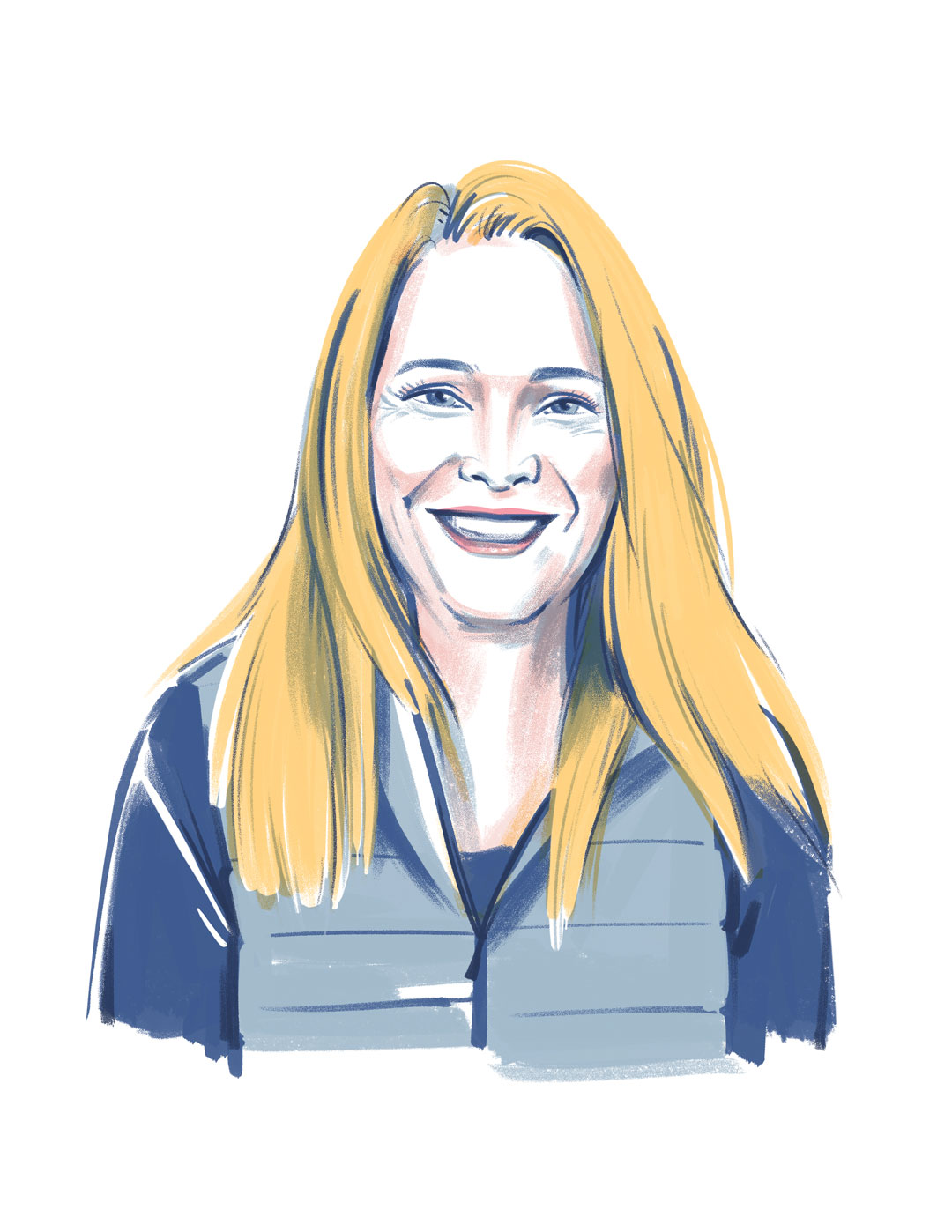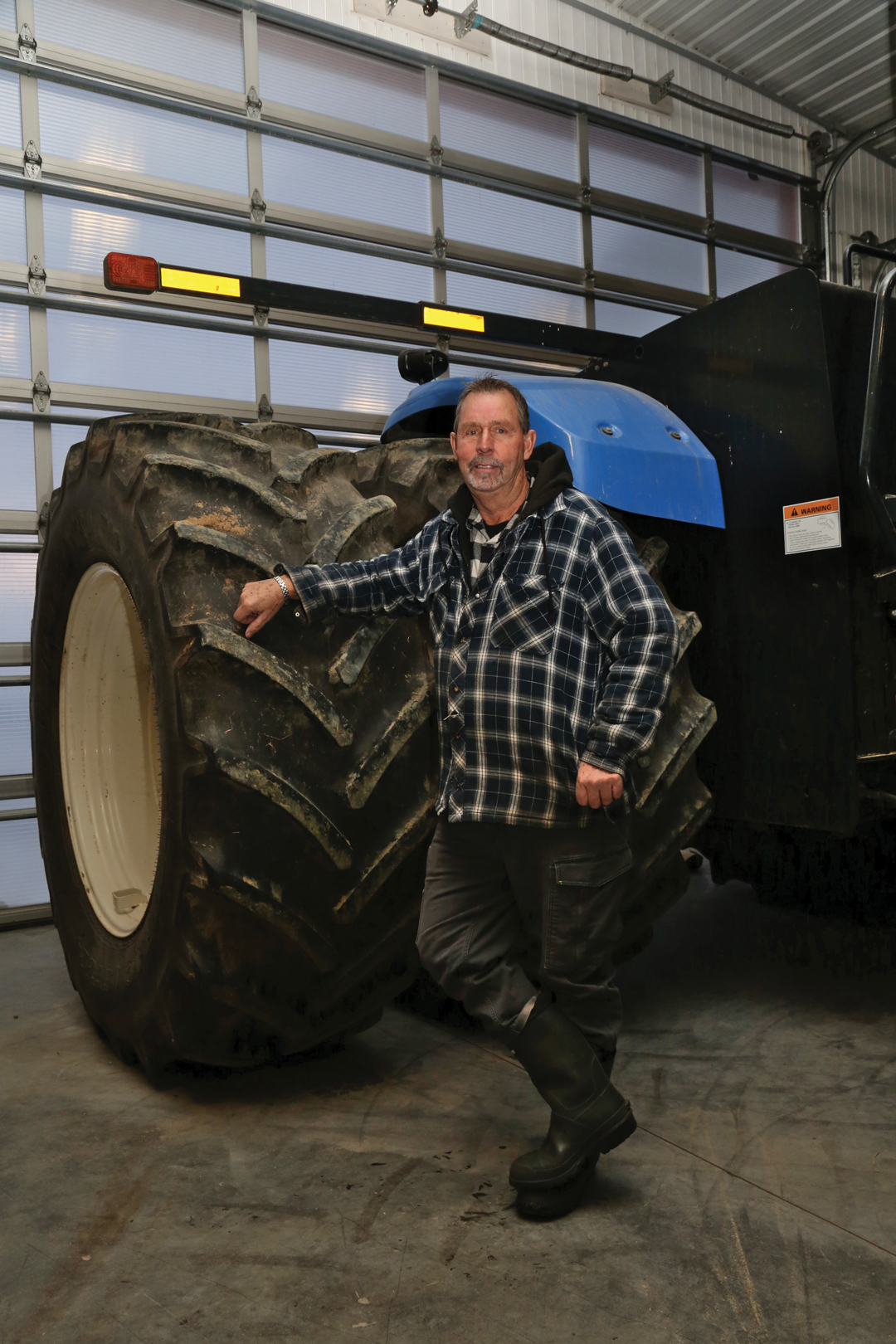THE VOICE
BY ELLEN COTTEE • ILLUSTRATION BY EMILY CHU
In September, as the economic fallout from the 2021 drought continued to hit home on Alberta farms, Pine Lake cattle farmer Kelly Smith-Fraser stepped into the role of Agriculture Financial Services Corporation (AFSC) board chair. It has not been an easy time to lead the group: insurance needs are high across the ag sector and AFSC has been tasked with administering the $340 million joint federal–provincial AgriRecovery program through the Canada-Alberta Livestock Feed Assistance Initiative.
Smith-Fraser is prepared for the challenge. With a lifetime of on-farm work and business management and a degree in marketing from Texas Tech University, she also has years of industry leadership experience. She was the first woman to chair Alberta Beef Producers, served as president of the Canadian Maine-Anjou Association and sat on the interim board for Results Driven Agriculture Research. She also now sits on the Canadian Cattlemen’s Association board.
GrainsWest: What was life like growing up on your family farm?
Kelly Smith-Fraser: My grandfather and nana built Poplar Haven Farms, our family farm in Wimborne. It was a mixed grain operation with a feedlot and Maine-Anjou cattle. My grandfather ran it with my dad and his two brothers. He passed away just after I was born, then it was run completely by the three sons. The three families worked together, lived within a mile of each other, rodeoed and showed cattle together. It was a phenomenal way to grow up.
GW: How was your current farm and business established?
KSF: We needed to split Poplar Haven up to bring in each of the kids who wanted to come home. One cousin was working there full time, and my brother, another cousin and myself had an interest in agriculture. It was decided we would split the farm three ways, and my family unit created NuHaven Cattle Company from our share.
GW: Have you always enjoyed working with family?
KSF: As a kid, I enjoyed the cattle and the horses, but I’ve always enjoyed the family side of the farm. As an adult, to work side by side with your dad is a gift a lot of people aren’t given. He passed away six years ago. My mom is still on the farm along with my husband Scott Fraser who works off-farm, and our 10-year-old daughter Aubrey who is already making plans to take over the farm. I think that’s awesome. There’s no pressure if she chooses not to, but she’s making great breeding decisions and developing her own herd. It’s pretty neat to
see how she makes her own plans and honestly, we take her input.
GW: What has driven you to be so engaged with farm organizations?
KSF: Growing up, my dad was very involved on boards. He was on the Alberta Cattle Commission in the ’80s, and very, very involved in what we call the industry politics. His line was, “If you aren’t sitting at that table, somebody else is, and you may not like what they have to say.” I really enjoy getting to work on behalf of producers, figuring out what we need to do next and where the industry is going.
Throughout the years, I’ve travelled to Ottawa and Edmonton lobbying on behalf of producers. It’s really satisfying to get to represent my fellow producers, to eventually see what we were lobbying for come to fruition and to know I’m even a small part of helping the whole industry.
GW: Why did you accept the role of AFSC chair?
KSF: We need to ensure that our business risk management programs are working for our producers and are accessible.
When the AFSC opportunity came along, to be a producer sitting in the chair role, I think it really gives us an awesome opportunity to connect back to the farmers and ranchers. I might not have the same crop as them, but they know that I’m in the same boat. This is what my life is.
It’s amazing to have the opportunity to engage with our producers in that way. I was incredibly honoured when [former] Minister of Agriculture Devin Dreeshen called and asked if I would be willing. It’s a huge job and I really want to make sure AFSC is doing its best for its clients and the industry.
GW: You joined AFSC at a difficult time, right in the aftermath of a very tough year for many farmers. What was your first impression being on the other side of the table?
KSF: I’ve been really impressed to see how the client relationships have been working. The staff have been phenomenal to work with and that makes me feel great for producers. I’ve even had to call in as a producer and it was great to have a friendly voice on the other end of the line doing everything they could for us. That makes me excited to know that, yes, even though we’re in a challenging time, our staff are doing their best and making sure we’re not adding to the stress producers are under right now.
GW: AFSC administers the Canada-Alberta Livestock Feed Assistance Initiative as part of the AgriRecovery initiative in response to these challenges. What has the uptake been like?
KSF: We just closed phase one on Nov. 1, and we’re still processing claims, but so far, the response has been incredible. There were more than 13,000 applications and approximately $150 million has been paid out to producers already [as of November 2021]. It was phenomenal to see the response from Alberta. As always, producers are resilient and inventive, but to see AFSC working really hard behind the scenes to develop the program and have producers receiving money before the end of September to help with feed costs was fantastic.
Phase two of this initiative will be open for applications through January 2022 and will use a feed-need calculation. Those who did not participate in phase one are still eligible to participate in phase two, and beekeepers will also be eligible for this phase. I encourage producers to apply early and online—AFSC teams are working hard to provide the best possible experience in delivering this second phase.
GW: AFSC has been subject to budget cuts and is now streamlining services. How will this affect producers?
KSF: We’re constantly reviewing how we are servicing our clients. Continually improving that service is really integral to how AFSC works. There are times when streamlining how we do things and becoming more efficient and sustainable makes sense, but the bottom line is we always need to give our clients the best customer service. As we saw through the [Feed Assistance Initiative], we were able to offer online services through AFSC Connect. AFSC was able to get applications processed quickly online. Then clients were able to receive the payments by direct deposit so they weren’t having to wait by the mailbox to get that cheque.
Relationships are always going to be number 1 for AFSC. This means ensuring clients can still have their in-person and on-farm appointments. Those are absolutely essential to the way AFSC will continue to do business. Hopefully, what farmers see is we’re doing business the way they want to do business, giving them the options to make our services accessible.
GW: AFSC also facilitates a lending program for farmers. How has that been received?
KSF: Coming into AFSC from my perspective and involvement in industry organizations, there is a really good understanding of the products we need to provide to our producers—not just agriculture, but also agribusiness. There’s definitely a significant mandate to drive agriculture, agribusiness and the related economic growth in Alberta. AFSC has doubled the individual lending limit to $30 million from $15 million. This increase is going to help us support some larger agribusiness deals throughout the province. In addition, AFSC is on pace for the second consecutive year of lending more than $600 million across the province. And that includes the entire ag value chain. We also have loan programs for primary producers. There is a phenomenal suite of programs out there and we’re seeing good, steady growth
GW: Speaking of growth, what are you most excited about in the future of the industry?
KSF: I always talk about how excited I am for our youth in agriculture. That’s been something that I’ve been working on a lot—trying to reach out to our youth and make sure they know there are industry organizations working on their behalf.
I think we also have a huge opportunity right now because our consumers are so engaged with their food. They want to know where it came from, how it was grown, everything. That is such a huge opportunity for all of agriculture to be telling our story while our consumers are really listening. This is an awesome time to be involved in agriculture.







Comments